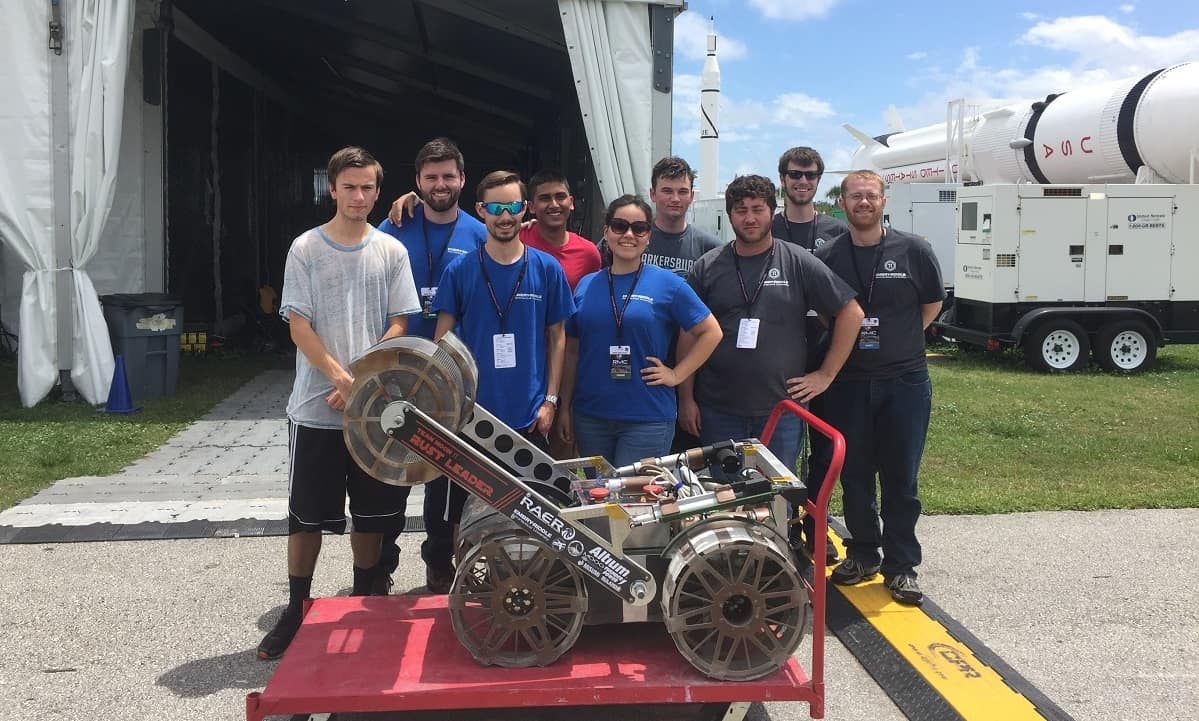Students Design Robot to Help with Mining Ice on Mars

NASA researchers have discovered thick deposits of ice beneath Mars' surface which will be key to sustaining human explorations on the dry planet, but getting to the frozen water underneath the ice-cemented rock and dust could be a challenge.
Embry-Riddle students hope to help solve the challenge by designing a robot to mine the ice, which could be used for human consumption, hygiene, growing of plants and even to make rocket propellant for the journey home.
The robot was built for NASA’s 9th annual Robotic Mining Competition at Kennedy Space Center (KSC) which took place May 14-18. This is the ninth year Embry–Riddle has been selected as one of about 50 universities and colleges.
Nine Embry-Riddle students from the Robotics Association on the Daytona Beach Campus majoring in computer science and mechanical, software, aerospace and electrical engineering participated in the competition. A high school student from St. Augustine, who previously attended a summer camp at Embry-Riddle, also was part of the team.
“The NASA Robotic Mining Competition provides students with hands-on exposure to systems engineering,” said Eric Coyle, Ph.D., Embry-Riddle associate professor of mechanical engineering and one of the faculty advisers for the team. “The experience and skills students learn by participating in this competition impact their academic and professional careers. “
At a special facility built to mimic the surface of Mars at KSC, the teams found out if their mining robots could traverse the simulated Martian terrain. Crushed lava basalt aggregate filled the competition arena area acting as the Martian basaltic regolith. The robots excavated the icy simulant (gravel) and returned the excavated mass for deposit into a collector bin to simulate an off-world mining mission.
The robots were either fully autonomous or remotely driven by students sequestered in trailers behind the competition area.
With deep-space missions planned in the future with longer travel times, sustainability is essential to allow humans to “live off the land” or what is called “In-Situ Resource Utilization (ISRU)”. According to NASA, resupply missions are expensive and exclusively relying on them may put crews at risk. The designs from the universities aid NASA in finding alternative practices to harnessing resources.
The Embry-Riddle robot, Rust Leader or Rusty, is named for the Rust Squadron Starfighter in Stars Wars, in keeping with the team’s Star Wars theme for the last few years. It was made from a welded aluminum frame with carbon fiber skin. This year’s robot had a new excavation system and student-designed electronic package to manage communication and power distribution. The excavation drums, located at the end of the robot’s arms, were made to filter out the loose regolith and leave only the rocks. Last year’s robotic system mined both parts of the surface.
“Another unique part of the robot was its “smart” power system which is comprised of custom hardware entirely designed by the students,” according to Nicholas Moline, team lead for the competition and an electrical engineering sophomore. “This power system incorporates built-in instrumentation to report the robot’s “health” to the main computer and programmable protection circuitry to make for a versatile design.”
While the team did not leave with an award, many of the unique features for this year’s robot were implemented to test their viability for next year’s design, which will have a legged locomotion system to solve the problems posed by the simulated Martian terrain.
“Working on the team has undoubtedly been the most valuable part of my college experience to date,” Moline said. “Through my two years on this project, I have acquired a large set of technical skills, obtained practical design experience, and learned a lot about the real world challenges engineering projects face, something you can’t get in the classroom.”
Zach Marion, an aerospace engineering senior, and Aleksandr Superczynski, an aerospace engineering junior, said they learned the important role communication plays when working as a team.
“Watching all the systems come together to produce a functional robot is one of the most satisfying feelings one can have,” Superczynski said.
Team members in the competition in addition to Moline, Marion and Superczynski were James Hendrickson, Andrew Ferree, Will Howard, Marc Lopez, Cameron Severin, Sashwat Acharya and high school student Isabella DeLorenzo. Associate professor of mechanical engineering Patrick Currier, Ph.D., and graduate student David Thompson also helped advise the team along with Coyle.

 Deborah Circelli
Deborah Circelli